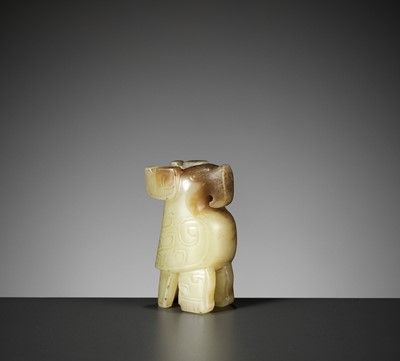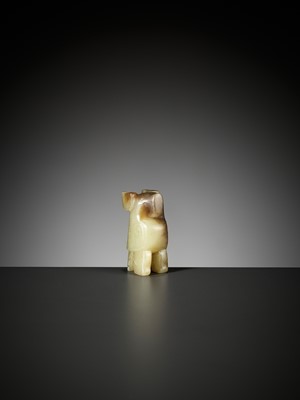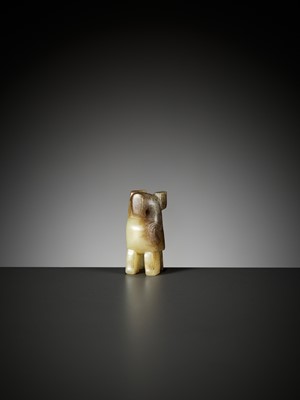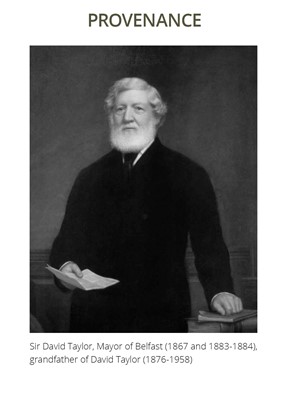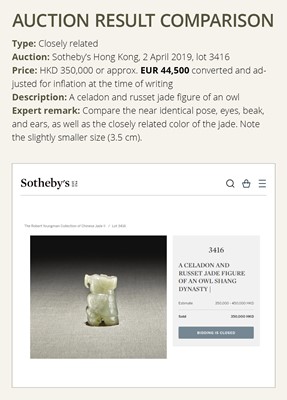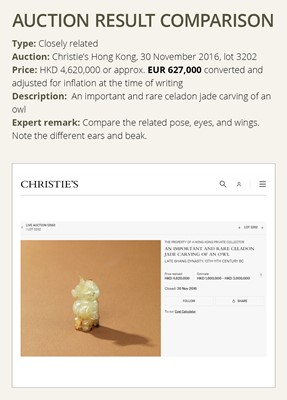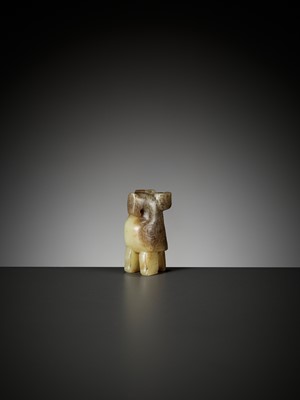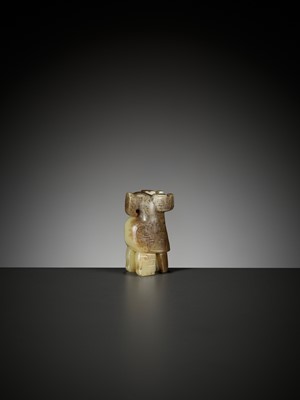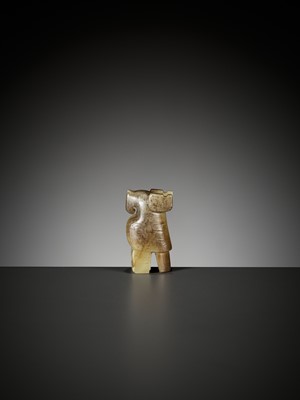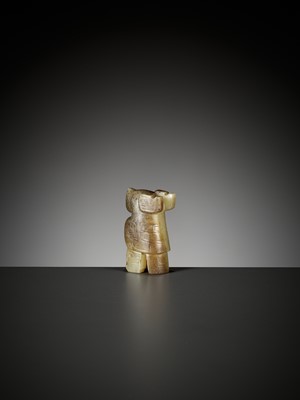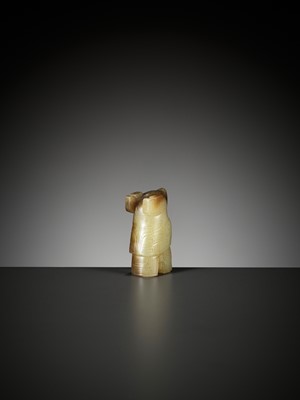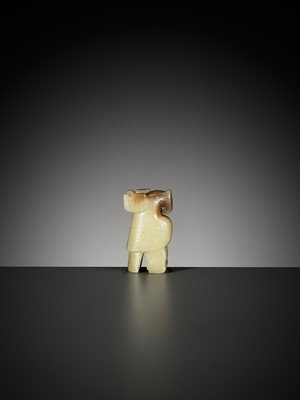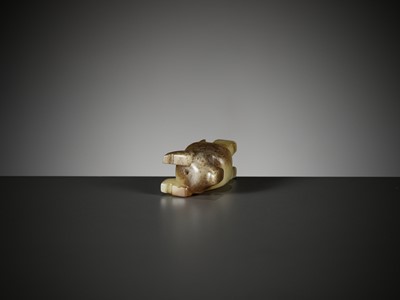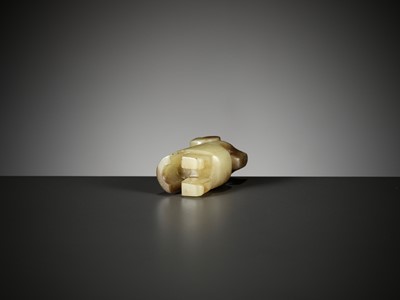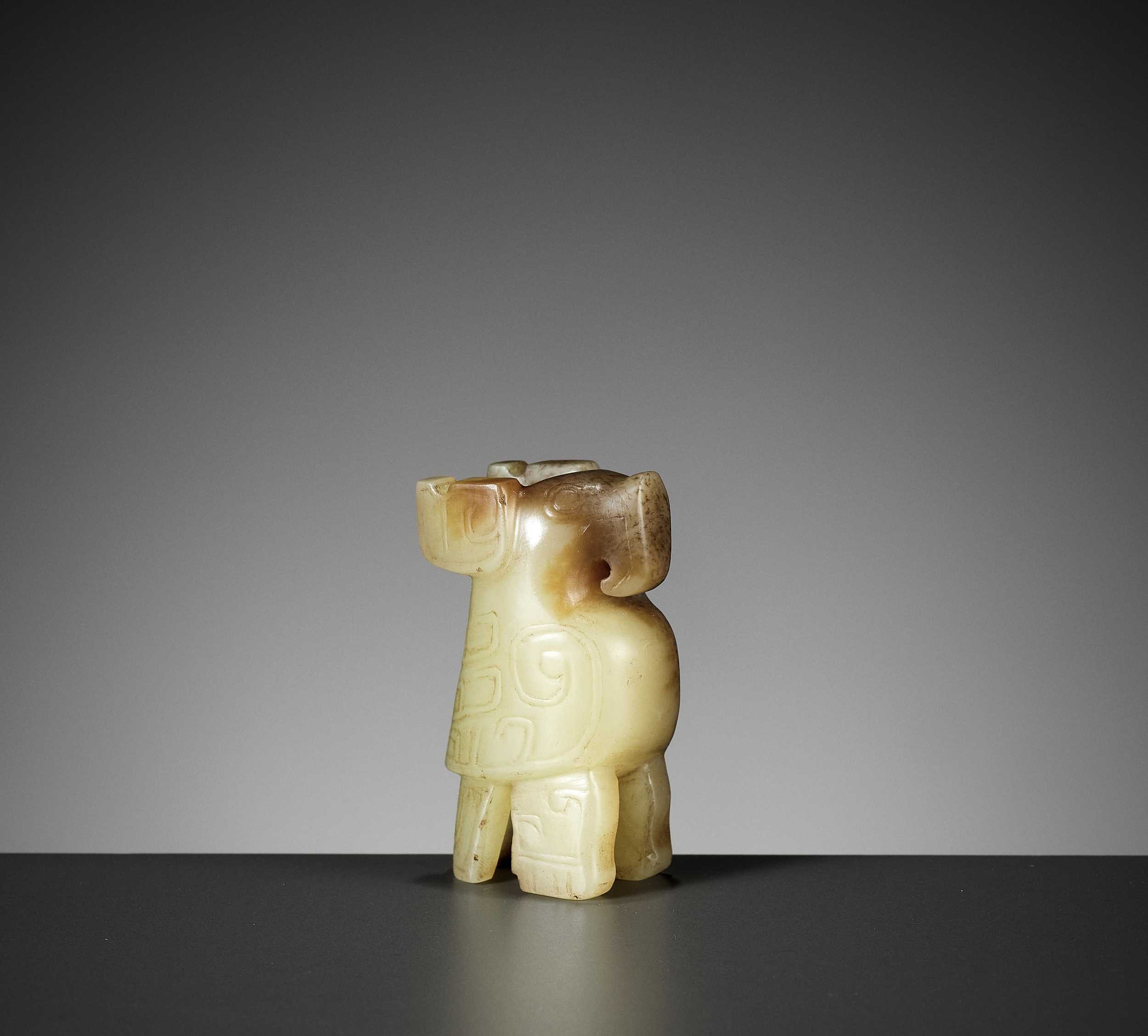29th Sep, 2022 13:00
DAY 1 - TWO-DAY AUCTION - Fine Chinese Art / 中國藝術集珍 / Buddhism & Hinduism
31
AN IMPORTANT AND RARE CELADON JADE CARVING OF AN OWL, LATE SHANG DYNASTY
晚商重要青玉鴟鴞
Sold for €14,300
including Buyer's Premium
China, 13th-11th century BC. Finely carved in the round as an owl standing on its feet and tail, with the head held high and accentuated with a pair of raised round eyes and sharp hooked beak, further portrayed with a pair of wings curving to the back of the figure. The back of the head is pierced at an angle with two holes connecting to each other. The translucent stone is of a slightly yellowish celadon tone with veins and areas of russet and pale gray and some dark brown specks.
Provenance: From the collection of David Taylor, and thence by descent within the Taylor family. David Taylor (1876-1958) was a notable British businessman who lived in Belfast and owned various commercial buildings along with a substantial portfolio of stocks and shares. During his travels to China in the early 20th century, he acquired many jades, including the present lot. His grandfather, Sir David Taylor, was born in 1815 in Perth, Scotland, and moved to Belfast in 1842, serving as its Mayor in 1867 and for two consecutive terms in 1883 and 1884.
Condition: Very good condition commensurate with age. Distinct old wear and weathering, the stone with few natural fissures, some of which may have developed into tiny hairline cracks over time. Minor nicks here and there, some shallow surface scratches.
Weight: 42.4 g
Dimensions: Height 4.5 cm
Depictions of owls feature prominently among the arts of the Shang dynasty. The bird’s nocturnal and binocular vision and its binaural hearing and hunting skill were revered from the Neolithic period, when the earliest jade carvings of owls were made. The owl’s terrifying screech would have fit the perception of abnormality in ritual and magic, and it is most likely that the bird played a significant role in Shang belief. It has been suggested that the mythical black bird (xuanniao) from which the Shang people were believed to have originated was in fact an owl. Alternatively, Sun Xinzhou has suggested that the mythical ancestor Di Jun (also known as Di Ku, Shun) can be identified with the owl deity protector of agriculture (Sun Xinzhou, ‘Chixiao chongbai huaxia lishi wenming’ [On the strigidae worship and historical civilization in China], Journal of Tianjin Normal University (Social Sciences), no. 5, 2004, pp 31-7).
Literature comparison:
Jade owls were excavated from the Tomb of Fu Hao in modern-day Anyang, Henan province, and illustrated in Tomb of Lady Hao at Yinxu, Beijing, 1980, pl. 137, nos. 1-3, together with a further related beaked bird with horns, pl. 134 no. 3. A related jade owl was included in the exhibition Chinese Jade Animals, Hong Kong Museum of Art, 1996, cat. no. 17. See also two marble owls, excavated from the Shang royal cemetery at Xibeigang, on the northern bank of the Huan river, one of which is illustrated in Cheng Te-K’un, Archaeology in China, vol. 2, Shang China, Cambridge, 1960, pl. Xa.
Auction result comparison:
Type: Closely related
Auction: Christie’s Hong Kong, 30 November 2016, lot 3202
Price: HKD 4,620,000 or approx. EUR 627,000 converted and adjusted for inflation at the time of writing
Description: An important and rare celadon jade carving of an owl
Expert remark: Compare the related pose, eyes, and wings. Note the different ears and beak.
Auction result comparison:
Type: Closely related
Auction: Sotheby’s Hong Kong, 2 April 2019, lot 3416
Price: HKD 350,000 or approx. EUR 44,500 converted and adjusted for inflation at the time of writing
Description: A celadon and russet jade figure of an owl
Expert remark: Compare the near identical pose, eyes, beak, and ears, as well as the closely related color of the jade. Note the slightly smaller size (3.5 cm).
晚商重要青玉鴟鴞
中國,公元前十三至十四世紀。青黃色玉,圓雕鴟鴞形,作昂首挺胸矗立狀。翹鼻、額尖和凸角。重環眼,眼珠圓瞪,目光犀利,勾喙回捲為一孔,頸短粗。頭後部有兩個相互連接的孔。前胸飽滿,翅羽收攏,歧尾略翹,腿粗壯,下出一短榫。隨體形佈局的雙線卷雲紋。質地細膩純淨。半透明的玉料帶有天然赤褐色和淺灰色紋理和一些深棕色斑點。
來源:David Taylor收藏,自此一直保存在Taylor家族中。David Taylor (1876-1958) 曾是一位著名的英國商人,住在貝爾法斯特,擁有各種商業建築以及大量股票和股份。二十世紀初,他到中國旅行時購買了許多玉器,包括現在的這件。他的祖父戴維·泰勒爵士 1815 年出生於蘇格蘭Perth,1842 年移居貝爾法斯特,1867 年擔任市長,1883 年和 1884 年連任。
品相:與年齡相稱,品相非常好。明顯的磨損和風化,輕微天然裂縫,隨著時間的推移,其中一些可能已經發展成微小的冲綫。局部小刻痕,表面有一些劃痕。
重量:42.4 克
尺寸:高4.5 厘米
鴟鴞,即貓頭鷹,這種夜深出沒的鳥類在商代藝術中有著很突出的地位。貓頭鷹夜間視覺、聽覺和嗅覺靈敏異常靈敏。擁有神秘力量,穿梭於人間與冥界,能成為生與死的橋樑,又可趕走邪靈厄運。有人認為,商代的玄鳥可能就是一隻貓頭鷹。孫新周在《鴟鴞崇拜與華夏曆史文明》中認爲殷商族圖騰"玄鳥"不是燕子,是鴟 ;高祖 (帝俊,帝嚳,舜)的原型是鴟;圖騰,它是商民族的生殖神,農業保護神和太陽神(《天津師範大學學報(社科版)》2004年)。
文獻比較:
玉鴟鴞出土於今河南安陽的婦好墓,並在《殷墟婦好墓》中得到說明,北京,1980年,圖137,第1-3號,還有一種相關的帶角的喙鳥,圖134第3號。一件相關的玉鴟鴞被列入《中國肖生玉雕》展覽,香港藝術博物館,1996年,圖錄號17。另見兩隻大理石貓頭鷹,出土於洹河北岸的西北岡商王大墓,其中一件見Cheng Te-K’un,《Archaeology in China》,第二卷,《Shang China》,劍橋,1960年,圖Xa。
拍賣結果比較:
形制:非常相近
拍賣:香港佳士得,2016年11月30日,lot 3202
價格:HKD 4,620,000(相當於今日EUR 627,000)
描述:晚商西元前十三至十一世紀重要青玉鴟鴞
專家評論:比較相近的姿勢、眼睛和翅膀。請注意耳朵和鳥嘴不同。
拍賣結果比較:
形制:非常相近
拍賣:香港蘇富比,2019年4月2日,lot 3416
價格:HKD 350,000(相當於今日EUR 44,500)
描述:商代青玉留皮鴟鴞
專家評論:比較一下近乎相同的姿勢、眼睛、嘴和耳朵,以及極相近的玉石顏色。請注意它的尺寸稍小 (3.5 厘米)。
China, 13th-11th century BC. Finely carved in the round as an owl standing on its feet and tail, with the head held high and accentuated with a pair of raised round eyes and sharp hooked beak, further portrayed with a pair of wings curving to the back of the figure. The back of the head is pierced at an angle with two holes connecting to each other. The translucent stone is of a slightly yellowish celadon tone with veins and areas of russet and pale gray and some dark brown specks.
Provenance: From the collection of David Taylor, and thence by descent within the Taylor family. David Taylor (1876-1958) was a notable British businessman who lived in Belfast and owned various commercial buildings along with a substantial portfolio of stocks and shares. During his travels to China in the early 20th century, he acquired many jades, including the present lot. His grandfather, Sir David Taylor, was born in 1815 in Perth, Scotland, and moved to Belfast in 1842, serving as its Mayor in 1867 and for two consecutive terms in 1883 and 1884.
Condition: Very good condition commensurate with age. Distinct old wear and weathering, the stone with few natural fissures, some of which may have developed into tiny hairline cracks over time. Minor nicks here and there, some shallow surface scratches.
Weight: 42.4 g
Dimensions: Height 4.5 cm
Depictions of owls feature prominently among the arts of the Shang dynasty. The bird’s nocturnal and binocular vision and its binaural hearing and hunting skill were revered from the Neolithic period, when the earliest jade carvings of owls were made. The owl’s terrifying screech would have fit the perception of abnormality in ritual and magic, and it is most likely that the bird played a significant role in Shang belief. It has been suggested that the mythical black bird (xuanniao) from which the Shang people were believed to have originated was in fact an owl. Alternatively, Sun Xinzhou has suggested that the mythical ancestor Di Jun (also known as Di Ku, Shun) can be identified with the owl deity protector of agriculture (Sun Xinzhou, ‘Chixiao chongbai huaxia lishi wenming’ [On the strigidae worship and historical civilization in China], Journal of Tianjin Normal University (Social Sciences), no. 5, 2004, pp 31-7).
Literature comparison:
Jade owls were excavated from the Tomb of Fu Hao in modern-day Anyang, Henan province, and illustrated in Tomb of Lady Hao at Yinxu, Beijing, 1980, pl. 137, nos. 1-3, together with a further related beaked bird with horns, pl. 134 no. 3. A related jade owl was included in the exhibition Chinese Jade Animals, Hong Kong Museum of Art, 1996, cat. no. 17. See also two marble owls, excavated from the Shang royal cemetery at Xibeigang, on the northern bank of the Huan river, one of which is illustrated in Cheng Te-K’un, Archaeology in China, vol. 2, Shang China, Cambridge, 1960, pl. Xa.
Auction result comparison:
Type: Closely related
Auction: Christie’s Hong Kong, 30 November 2016, lot 3202
Price: HKD 4,620,000 or approx. EUR 627,000 converted and adjusted for inflation at the time of writing
Description: An important and rare celadon jade carving of an owl
Expert remark: Compare the related pose, eyes, and wings. Note the different ears and beak.
Auction result comparison:
Type: Closely related
Auction: Sotheby’s Hong Kong, 2 April 2019, lot 3416
Price: HKD 350,000 or approx. EUR 44,500 converted and adjusted for inflation at the time of writing
Description: A celadon and russet jade figure of an owl
Expert remark: Compare the near identical pose, eyes, beak, and ears, as well as the closely related color of the jade. Note the slightly smaller size (3.5 cm).
晚商重要青玉鴟鴞
中國,公元前十三至十四世紀。青黃色玉,圓雕鴟鴞形,作昂首挺胸矗立狀。翹鼻、額尖和凸角。重環眼,眼珠圓瞪,目光犀利,勾喙回捲為一孔,頸短粗。頭後部有兩個相互連接的孔。前胸飽滿,翅羽收攏,歧尾略翹,腿粗壯,下出一短榫。隨體形佈局的雙線卷雲紋。質地細膩純淨。半透明的玉料帶有天然赤褐色和淺灰色紋理和一些深棕色斑點。
來源:David Taylor收藏,自此一直保存在Taylor家族中。David Taylor (1876-1958) 曾是一位著名的英國商人,住在貝爾法斯特,擁有各種商業建築以及大量股票和股份。二十世紀初,他到中國旅行時購買了許多玉器,包括現在的這件。他的祖父戴維·泰勒爵士 1815 年出生於蘇格蘭Perth,1842 年移居貝爾法斯特,1867 年擔任市長,1883 年和 1884 年連任。
品相:與年齡相稱,品相非常好。明顯的磨損和風化,輕微天然裂縫,隨著時間的推移,其中一些可能已經發展成微小的冲綫。局部小刻痕,表面有一些劃痕。
重量:42.4 克
尺寸:高4.5 厘米
鴟鴞,即貓頭鷹,這種夜深出沒的鳥類在商代藝術中有著很突出的地位。貓頭鷹夜間視覺、聽覺和嗅覺靈敏異常靈敏。擁有神秘力量,穿梭於人間與冥界,能成為生與死的橋樑,又可趕走邪靈厄運。有人認為,商代的玄鳥可能就是一隻貓頭鷹。孫新周在《鴟鴞崇拜與華夏曆史文明》中認爲殷商族圖騰"玄鳥"不是燕子,是鴟 ;高祖 (帝俊,帝嚳,舜)的原型是鴟;圖騰,它是商民族的生殖神,農業保護神和太陽神(《天津師範大學學報(社科版)》2004年)。
文獻比較:
玉鴟鴞出土於今河南安陽的婦好墓,並在《殷墟婦好墓》中得到說明,北京,1980年,圖137,第1-3號,還有一種相關的帶角的喙鳥,圖134第3號。一件相關的玉鴟鴞被列入《中國肖生玉雕》展覽,香港藝術博物館,1996年,圖錄號17。另見兩隻大理石貓頭鷹,出土於洹河北岸的西北岡商王大墓,其中一件見Cheng Te-K’un,《Archaeology in China》,第二卷,《Shang China》,劍橋,1960年,圖Xa。
拍賣結果比較:
形制:非常相近
拍賣:香港佳士得,2016年11月30日,lot 3202
價格:HKD 4,620,000(相當於今日EUR 627,000)
描述:晚商西元前十三至十一世紀重要青玉鴟鴞
專家評論:比較相近的姿勢、眼睛和翅膀。請注意耳朵和鳥嘴不同。
拍賣結果比較:
形制:非常相近
拍賣:香港蘇富比,2019年4月2日,lot 3416
價格:HKD 350,000(相當於今日EUR 44,500)
描述:商代青玉留皮鴟鴞
專家評論:比較一下近乎相同的姿勢、眼睛、嘴和耳朵,以及極相近的玉石顏色。請注意它的尺寸稍小 (3.5 厘米)。
Zacke Live Online Bidding
Our online bidding platform makes it easier than ever to bid in our auctions! When you bid through our website, you can take advantage of our premium buyer's terms without incurring any additional online bidding surcharges.
To bid live online, you'll need to create an online account. Once your account is created and your identity is verified, you can register to bid in an auction up to 12 hours before the auction begins.
Intended Spend and Bid Limits
When you register to bid in an online auction, you will need to share your intended maximum spending budget for the auction. We will then review your intended spend and set a bid limit for you. Once you have pre-registered for a live online auction, you can see your intended spend and bid limit by going to 'Account Settings' and clicking on 'Live Bidding Registrations'.
Your bid limit will be the maximum amount you can bid during the auction. Your bid limit is for the hammer price and is not affected by the buyer’s premium and VAT. For example, if you have a bid limit of €1,000 and place two winning bids for €300 and €200, then you will only be able to bid €500 for the rest of the auction. If you try to place a bid that is higher than €500, you will not be able to do so.
Online Absentee and Telephone Bids
You can now leave absentee and telephone bids on our website!
Absentee Bidding
Once you've created an account and your identity is verified, you can leave your absentee bid directly on the lot page. We will contact you when your bids have been confirmed.
Telephone Bidding
Once you've created an account and your identity is verified, you can leave telephone bids online. We will contact you when your bids have been confirmed.
Classic Absentee and Telephone Bidding Form
You can still submit absentee and telephone bids by email or fax if you prefer. Simply fill out the Absentee Bidding/Telephone bidding form and return it to us by email at office@zacke.at or by fax at +43 (1) 532 04 52 20. You can download the PDF from our Upcoming Auctions page.
How-To Guides
How to Create Your Personal Zacke Account
How to Register to Bid on Zacke Live
How to Leave Absentee Bids Online
How to Leave Telephone Bids Online
中文版本的操作指南
创建新账号
注册Zacke Live在线直播竞拍(免平台费)
缺席投标和电话投标
Third-Party Bidding
We partner with best-in-class third-party partners to make it easy for you to bid online in the channel of your choice. Please note that if you bid with one of our third-party online partners, then there will be a live bidding surcharge on top of your final purchase price. You can find all of our fees here. Here's a full list of our third-party partners:
- 51 Bid Live
- EpaiLive
- ArtFoxLive
- Invaluable
- LiveAuctioneers
- the-saleroom
- lot-tissimo
- Drouot
Please note that we place different auctions on different platforms. For example, in general, we only place Chinese art auctions on 51 Bid Live.
Bidding in Person
You must register to bid in person and will be assigned a paddle at the auction. Please contact us at office@zacke.at or +43 (1) 532 04 52 for the latest local health and safety guidelines.
